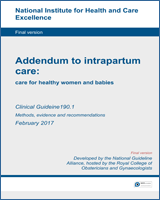From: Appendix I, GRADE tables

NCBI Bookshelf. A service of the National Library of Medicine, National Institutes of Health.
| Quality assessment | Definition of outcome | Stage of labour | Total number of women & baby pairs | Measure of diagnostic accuracy (95% CI) | Quality | ||||||||
|---|---|---|---|---|---|---|---|---|---|---|---|---|---|
| Number of studies | Design | Risk of bias | Inconsistency | Indirectness | Imprecision | Sensitivity | Specificity | Positive likelihood ratio | Negative likelihood ratio | ||||
| Indeterminate FHR tracing (NICHD classification 2008) | |||||||||||||
|
1 study | Prospective cohort | Very serious1 | No serious inconsistency | No serious indirectness | No serious imprecision | Caesarean section | In early labour during a 20–40 minute period | 326 (normal n=249, indeterminate n=77) | 33.1%a | 83.4%a | 1.99a,b | 0.80a,b | Low |
| “Abnormal” FHR pattern (Category III, NICHD classification 2008) | |||||||||||||
|
1 study | Retrospective cohort | Very serious2 | No serious inconsistency | No serious indirectness | No serious imprecision | Instrumental birth | At least 1 hour and up to 5 hours before birth | 314 (normal n=108, category III n=31, category IIA n=118, category IIB n=57) |
20.4% (13.0 to 30.3)b |
73.9% (58.6 to 85.2)b |
0.78 (0.42 to 1.47)b |
1.08 (0.9 6 to 1.21)b | Very low |
|
1 study | Retrospective cohort | Very serious2 | No serious inconsistency | No serious indirectness | Serious3 | Instrumental birth for suspected fetal distress | At least 1 hour and up to 5 hours before birth | 314 (normal n=108, category III n=31, category IIA n=118, category IIB n=57) |
42.9% (28.1 to 58.9)b |
86.6% (77.8 to 92.4)b |
3.20 (1.73 to 5.91)b |
0.66 (0.5 1 to 0.86)b | Very low |
| “Indeterminate” FHR pattern with minimal/absent baseline FHR variability and no FHR accelerations (Category IIB, NICHD classification 2008 with subcategorisation according to ACOG guidelines) | |||||||||||||
|
1 study | Retrospective cohort | Very serious2 | No serious inconsistency | No serious indirectness | No serious imprecision | Instrumental birth | At least 1 hour and up to 5 hours before birth | 314 (normal n=108, category III n=31, category IIA n=118, category IIB n=57) |
28.9% (20.6 to 38.7)b |
55.7% (42.5 to 68.2)b |
0.65 (0.43 to 0.98)b |
1.28 (1.1 0 to 1.48)b | Very low |
|
1 study | Retrospective cohort | Very serious2 | No serious inconsistency | No serious indirectness | Serious4 | Instrumental birth for suspected fetal distress | At least 1 hour and up to 5 hours before birth | 314 (normal n=108, category III n=31, category IIA n=118, category IIB n=57) |
54.7% (40.6 to 68.2)b |
75.0% (65.8 to 82.5)b |
2.19 (1.46 to 3.28)b |
0.60 (0.4 5 to 0.82)b | Very low |
| “Indeterminate” FHR pattern with moderate FHR variability or FHR accelerations (Category IIA, NICHD classification 2008 with subcategorisation according to ACOG guidelines) | |||||||||||||
|
1 study | Retrospective cohort | Very serious2 | No serious inconsistency | No serious indirectness | No serious imprecision | Instrumental birth | At least 1 hour and up to 5 hours before birth | 314 (normal n=108, category III n=31, category IIA n=118, category IIB n=57) |
49.7% (41.4 to 58.0)b |
43.0% (32.1 to 54.6)b |
0.87 (0.68 to 1.12)b |
1.17 (0.96 to 1.42)b | Very low |
|
1 study | Retrospective cohort | Very serious2 | No serious inconsistency | No serious indirectness | Serious4 | Instrumental birth for suspected fetal distress | At least 1 hour and up to 5 hours before birth | 314 (normal n=108, category III n=31, category IIA n=118, category IIB n=57) |
67.6% (55.6 to 77.7)b |
55.3% (47.0 to 63.3)b |
1.51 (1.19 to 1.91)b |
0.59 (0.42 to 0.82)b | Very low |
ACOG American College of Obstetricians and Gynecologists; CI confidence interval; FHR hetal heart rate; NICHD National Institute of Child Health and Human Development
95% CI not calculable from data reported in the article
Calculated by the 2017 NGA technical team
Unclear if consecutive enrolment of participants was done; no blinding for CTG tracing findings when ascertainment of outcome was done; late preterm births were included; events independent of CTG tracing findings might have influenced the outcome.
No random sampling; only one expert interpreted all the tracings; unclear if and why population was considered high risk; no blinding for CTG tracing findings when ascertainment of outcome was done; events independent of CTG tracing findings might have influenced the outcome
95% CI for the positive likelihood ratio crosses 5
95% CI for the negative likelihood ratio crosses 0.5
From: Appendix I, GRADE tables

NCBI Bookshelf. A service of the National Library of Medicine, National Institutes of Health.